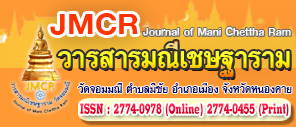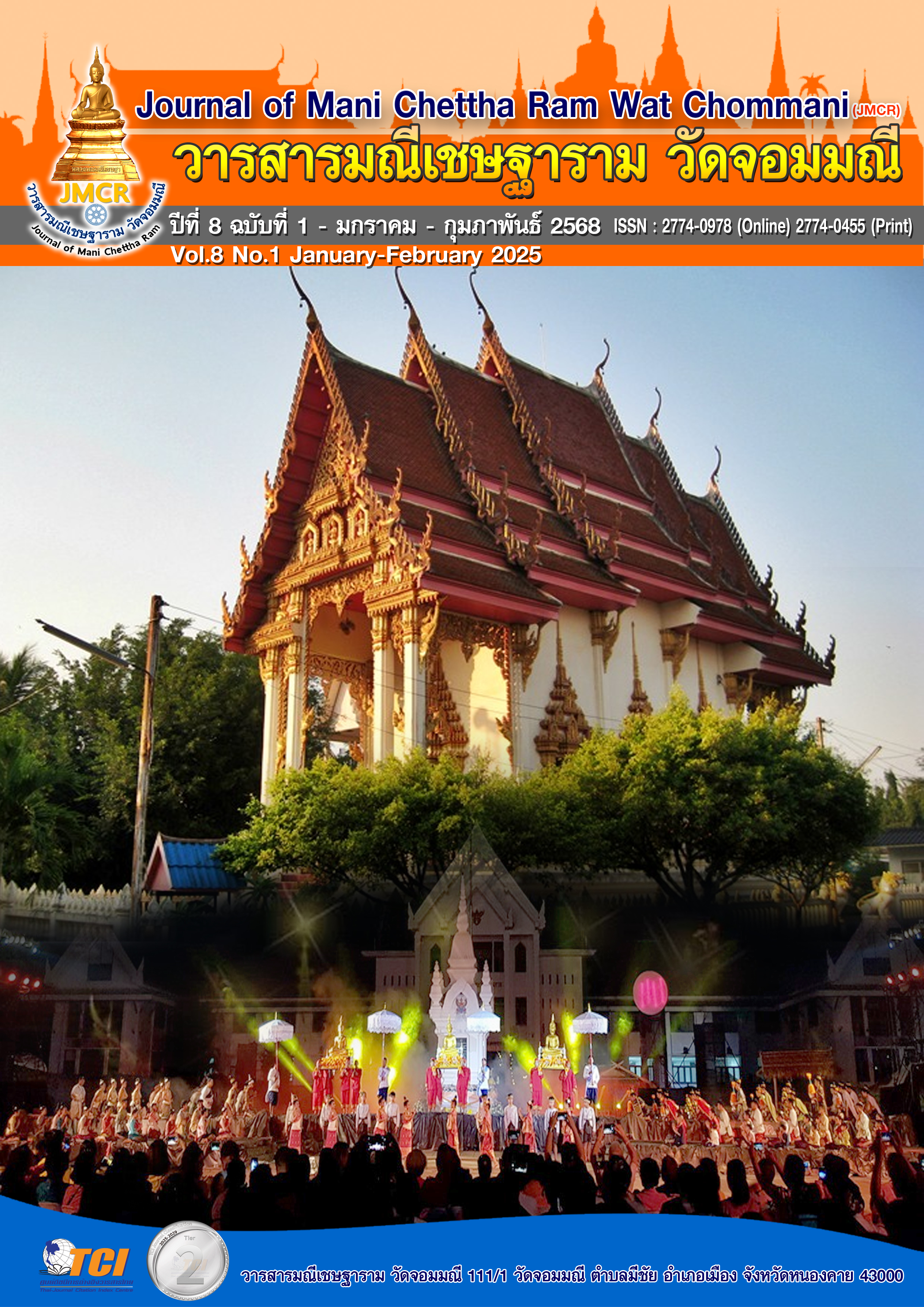A MANAGEMENT MODEL TO DEVELOP THE INTERNAL QUALITY ASSURANCE SYSTEM FOR SCHOOLS UNDER NAKHONSAWANPRIMARY EDUCATIONAL SERVICE AREA OFFICE 1 ON DUTIYAPÂPANIKA SUTTA
Keywords:
Administrator, Internal Quality Assurance Model, DutiyapapanikasuttaAbstract
The objectives of this research were 1) to analyze the management components for developing an internal quality assurance system in schools under the Office of the Primary Educational Service Area 1 Nakhon Sawan, 2) to create a management model for developing an internal quality assurance system in schools under the Office of the Primary Educational Service Area 1 Nakhon Sawan based on the Dutiyapapanika Sutta, and 3) to evaluate the management model for developing an internal quality assurance system in schools under the Office of the Primary Educational Service Area 1 Nakhon Sawan based on the Dutiyapapanika Sutta. The samples consisted of school administrators, academic teachers, teachers responsible for primary school quality assurance, and teachers responsible for early childhood quality assurance, totaling 452 people in 113 schools. The tools used for data collection were interviews, questionnaires, and model evaluation and approval forms. The statistics used for data analysis were frequency, percentage, mean, and standard deviation. Exploratory Factor Analysis (EFA)
The research results found that
- The analysis of the components of management to develop the internal quality assurance system of schools under the Office of the Primary Educational Service Area 1, Nakhon Sawan, resulted in 7 components and 82 variables.
- The management model to develop the internal quality assurance system of schools under the Office of the Primary Educational Service Area 1, Nakhon Sawan, according to the principles of the Dutiyapapanika Sutta, consists of 3 parts: (1) Introduction; (2) Content and guidelines for operations, including Component 1: Leadership of school administrators; Component 2: School administration resources; Component 3: School management; Component 4: Student-centered teaching and learning; Component 5: Monitoring, monitoring and evaluation of education management; Component 6: Creating a collaborative network for education management; and Component 7: Student quality development; and (3) Conditions for success.
3.The results of the evaluation of the management model to develop the internal quality assurance system of schools under the Office of the Primary Educational Service Area 1, Nakhon Sawan, according to the principles of the Dutiyapapanika Sutta found that it was correct, feasible, appropriate and useful at the highest level.
References
กระทรวงศึกษาธิการ. (2542). การจัดการเรียนการสอนที่เน้นผู้เรียนเป็นศูนย์กลาง. เอกสารชุดแนวทางการปฏิรูปการศึกษาในโรงเรียนสังกัดกรมสามัญศึกษา. กรุงเทพมหานคร: โรงพิมพ์การศาสนา.
ณัฐตะวัน ลิ้มประสงค์. (2556). การบริหารจัดการการประกันคุณภาพสถานศึกษาสำหรับอนาคต. ใน วิทยานิพนธ์ปริญญาปรัชญาดุษฎีบัณฑิต สาขาวิชาการบริหารการศึกษา. มหาวิทยาลัยศิลปากร.
นิรมล รอดไพ. (2564). การพัฒนารูปแบบการประกันคุณภาพภายในสถานศึกษาของผู้บริหารโรงเรียนมัธยมศึกษาในสำนักงานเขตพื้นที่การศึกษามัธยมศึกษา นครสวรรค์ตามหลักทุติยปาปณิกสูตร. ใน วิทยานิพนธ์ปริญญาครุศาสตรดุษฎีบัณฑิต สาขาวิชาพุทธบริหารการศึกษา. มหาวิทยาลัยมหาจุฬาลงกรณราชวิทยาลัย.
สมรัฐ แก้วสังข์. (2557). องค์ประกอบและตัวบ่งชี้การบริหารสถานศึกษาขั้นพื้นฐานในเขตพัฒนาพิเศษเฉพาะกิจจังหวัดชายแดนภาคใต้. ใน วิทยานิพนธ์ปริญญาปรัชญาดุษฎีบัณฑิต สาขาวิชาการบริหารการศึกษา. มหาวิทยาลัยศิลปากร.
สำนักงานเขตพื้นที่การศึกษาประถมศึกษานครสวรรค์ เขต 1 (2566). แผนพัฒนาการศึกษาขั้นพื้นฐาน (พ.ศ.2566-พ.ศ.2570), สืบค้นเมื่อ 5 สิงหาคม 2566. จาก : https://www.nsw1.go.th.
สำนักงานคณะกรรมการการศึกษาขั้นพื้นฐาน. (2561). แนวทางการประเมินคุณภาพตามมาตรฐานการศึกษาระดับปฐมวัย ระดับการศึกษาขั้นพื้นฐาน และระดับการศึกษาขั้นพื้นฐานศูนย์การศึกษาพิเศษ. กรุงเทพมหานคร: ชุมนุมสหกรณ์การเกษตรแห่งประเทศไทย.
สำนักงานเลขาธิการสภาการศึกษา. (2562). มาตรฐานการศึกษาของชาติ พ.ศ. 2561. กรุงเทพมหานคร: บริษัท 21 เซ็นจูรี่ จำกัด.
สำนักทดสอบทางการศึกษา. (2561). แนวทางการประเมินคุณภาพตามมาตรฐานการศึกษาระดับปฐมวัยระดับการศึกษาขั้นพื้นฐาน และระดับการศึกษาขั้นพื้นฐานศูนย์การศึกษาพิเศษ. กรุงเทพมหานคร: โรงพิมพ์ชุมนุมสหกรณ์การเกษตรแห่งประเทศไทย จำกัด.
สมประสงค์ ยมนา. (2560). การพัฒนารูปแบบการบริหารจัดการประกันคุณภาพภายในสถานศึกษาขนาดเล็กสังกัดสำนักงานคณะกรรมการการศึกษาขั้นพื้นฐาน. ใน วิทยานิพนธ์ครุศาสตรดุษฎีบัณฑิต สาขาวิชาการบริหารการศึกษา. มหาวิทยาลัยราชภัฏอุบลราชธานี.
อุดม อรุณราช. (2563).องค์ประกอบการประกันคุณภาพการศึกษาของสถานศึกษาขั้นพื้นฐาน. ใน วิทยานิพนธ์ปรัชญาดุษฎีบัณฑิต สาขาวิชาการบริหารการศึกษา. มหาวิทยาลัยศิลปากร.
Joseph, Mathew and Beatriz Joseph. (1997). Service quality in education: a student perspective. Quality Assurance in Education 5.
Krejcie, R. & Morgan. (1970). Determining sample sizes for research activities. Educational and Psychological Measurement, 30, 607-610.
Likert, R. (1967). The human organization: Its management and value. New York: McGraw-Hill.
Willer, D.(1986). Scientific sociology: Theory and method. Englewood Cliff. N.J.:Prentice-Hall.


